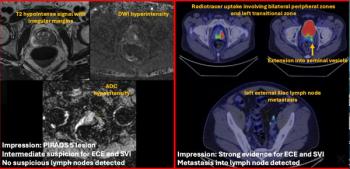
CAD holds key to increased CT colonography screening
Few radiologists would disagree that computer-assisted detection in the colon has a long way to go before it is ready for routine clinical implementation. But once the technical challenges have been overcome, advocates for CT colonography screening will have a far stronger case, according to speakers at the Computer Assisted Radiology and Surgery meeting in June.
Few radiologists would disagree that computer-assisted detection in the colon has a long way to go before it is ready for routine clinical implementation. But once the technical challenges have been overcome, advocates for CT colonography screening will have a far stronger case, according to speakers at the Computer Assisted Radiology and Surgery meeting in June.
Unlike most other malignancies, colon cancer progresses relatively slowly from precancerous morphology to invasive malignancy, giving doctors a long window of opportunity to detect and treat early-stage disease.
"Over 95% of colon cancers arise from benign polyps. When using the right approach to CT colonography, we are able to detect even the smallest polyp," said Dr. Patrik Rogalla, a radiologist at the Charite Campus Mitte, Medical University of Berlin.
The time taken to review CT colonography data, however, has raised questions about the technique's practicality in a screening setting. The precise manner in which exams are performed and interpreted also makes a significant difference in sensitivity and specificity.
Practitioners have a choice of patient preparation strategies, scanner setup and acquisition parameters, and methods of reviewing the CT data. While one center may use fecal tagging, scan patients in a prone position, and look immediately at reconstructed 3D views, another may rely on bowel cleansing agents, scan patients in prone and supine positions, and review 2D slices as a primary read. In the absence of a standardized exam protocol, it is not surprising that reported figures of CT colonography's efficacy vary, and debates over the reasons for such variation continue.
To make the best use of CT colonography, Rogalla recommended the following:
- shorter patient preparation, including less use of bowel cleansing agents and a shift toward fecal tagging;
- easy autonavigation tools for reviewing 3D CT data;
- complete backward and forward evaluation of the bowel wall to eliminate blind spots on 3D views;
- autosynchronization of supine and prone series if both are acquired; and
- use of CAD to highlight suspect polyps.
All these actions would make performing 3D primary reads time-efficient, Rogalla said.
"If it takes more than half an hour for a radiologist to go through a poorly prepped case, this tool will never take off," he said.
At least five companies and several academic institutions are working on colon CAD packages, according to Hiroyuki Yoshida, Ph.D., an associate professor of radiology at the University of Chicago. Each will need to tackle four major hurdles before claiming a clinically viable product.
Colon CAD systems generally work by segmenting the colon wall, detecting candidate polyps, eliminating likely false-positive results, and displaying suspect polyps. The first step may be complicated if the bowel wall is not fully distended or has been insufficiently cleansed, Yoshida said. Polyp detection, which is usually based on shape analysis, can have difficulty with polyps that are flat, depressed, smaller than 5 mm, or obscured by artifacts. And bowel folds and residual stool may not be recognized as false positives. Finally, colon CAD results must be optimally integrated into radiology workflow.
The main challenge is to substantially reduce the false-positive rate while maintaining a high sensitivity. Large-scale evaluation of large data sets with at least 1000 polyps is needed to achieve this goal, he said.
Newsletter
Stay at the forefront of radiology with the Diagnostic Imaging newsletter, delivering the latest news, clinical insights, and imaging advancements for today’s radiologists.




























